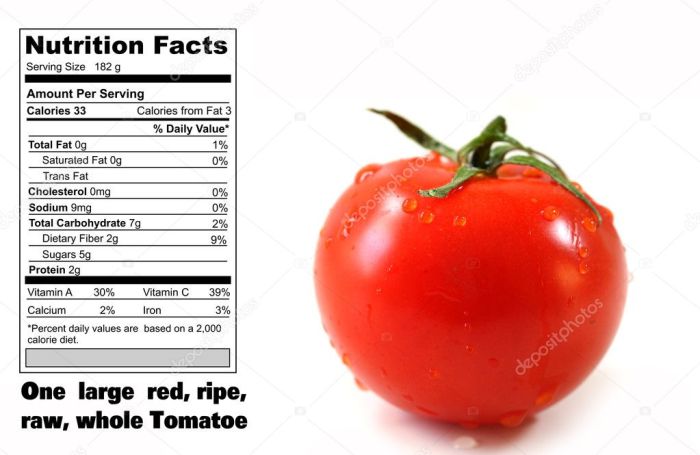Nutritional Profile of Cherry Tomatoes

Cherry tomato nutrition facts – Cherry tomatoes, those bite-sized bursts of sweetness, offer a surprising nutritional punch. While often perceived as a snack, they contribute significantly to a balanced diet, providing essential vitamins, minerals, and antioxidants. This section delves into the detailed nutritional composition of these miniature fruits and compares their nutritional value to other popular vegetables.
Cherry Tomato Nutritional Breakdown per 100g
The following table presents a comprehensive overview of the nutritional content found in 100 grams of cherry tomatoes. These values are approximate and can vary slightly depending on factors such as growing conditions and variety. It’s important to note that Daily Value percentages are based on a 2,000-calorie diet.
| Name | Amount | Unit | Daily Value Percentage |
|---|---|---|---|
| Vitamin A | 833 mcg | mcg RAE | 9% |
| Vitamin C | 12 mg | mg | 13% |
| Vitamin K | 9.3 mcg | mcg | 8% |
| Potassium | 240 mg | mg | 5% |
| Manganese | 0.1 mg | mg | 6% |
| Lycopene | ~6 mg | mg | – |
Lycopene Content in Cherry Tomatoes
Cherry tomatoes are a particularly good source of lycopene, a powerful antioxidant known for its potential health benefits. While the exact amount of lycopene varies depending on the cultivar and growing conditions, cherry tomatoes generally contain a higher concentration of lycopene than larger tomato varieties, such as beefsteak tomatoes. This higher concentration is partly attributed to their smaller size and thicker skin, which protects the lycopene from degradation.
Cherry tomatoes are a nutritional powerhouse, boasting vitamins A and C, along with potassium. However, for a different source of healthy fats and protein, you might consider checking out the nutritional details of peanut butter nutrition facts , which offers a contrasting nutritional profile. Returning to cherry tomatoes, their low calorie count makes them a great addition to any healthy diet.
The increased lycopene content contributes to their vibrant red color and potential health benefits.
Nutritional Comparison with Other Vegetables, Cherry tomato nutrition facts
Compared to other common vegetables, cherry tomatoes stand out in their lycopene content and vitamin C contribution. While bell peppers also offer a good source of vitamin C, cherry tomatoes provide a higher concentration of lycopene. Cucumbers, on the other hand, are lower in both lycopene and vitamin C, but offer higher water content and contribute to hydration. The specific nutritional profile varies significantly across different vegetable types, making a diverse intake crucial for optimal health.
A balanced diet that includes a variety of vegetables like cherry tomatoes, bell peppers, and cucumbers ensures a wide spectrum of vitamins, minerals, and antioxidants.
Visual Representation of Cherry Tomato Nutrition

The vibrant appearance of a cherry tomato is a visual testament to its nutritional richness. Its compact size and bright color immediately suggest a burst of flavor and a concentration of beneficial compounds. Examining the tomato’s physical characteristics provides clues to its nutritional profile.The typical cherry tomato boasts a smooth, slightly glossy skin, ranging in color from the classic deep red to vibrant yellow or even a dark, almost black hue.
These variations in color reflect differences in antioxidant content and other nutritional components. Their size is generally uniform, averaging about one inch in diameter, making them easily consumed whole. The firm yet slightly yielding texture hints at the abundance of water and fiber within.
Cherry Tomato Color Variations and Nutritional Differences
The color of a cherry tomato is a strong indicator of its nutritional profile. Different pigments contribute to the varied colors and offer unique health benefits. Red cherry tomatoes, for instance, owe their color to lycopene, a potent antioxidant associated with reduced risk of certain cancers and heart disease. Yellow cherry tomatoes contain more beta-carotene, a precursor to vitamin A, essential for vision and immune function.
Black cherry tomatoes, a relatively newer variety, are rich in anthocyanins, powerful antioxidants linked to improved brain health and reduced inflammation. While the exact nutritional content varies based on growing conditions and cultivar, these color variations represent a spectrum of beneficial compounds. A diet incorporating a variety of colored cherry tomatoes offers a wider range of nutritional benefits.
Key Questions Answered: Cherry Tomato Nutrition Facts
Are cherry tomatoes a good source of fiber?
Yes, cherry tomatoes provide a modest amount of dietary fiber, contributing to digestive health.
Can I eat cherry tomatoes if I have a potassium-restricted diet?
Individuals on potassium-restricted diets should monitor their intake of cherry tomatoes as they contain a moderate amount of potassium. Consult your doctor or registered dietitian for personalized guidance.
How should I store cherry tomatoes to maintain their nutritional value?
Store cherry tomatoes at room temperature, away from direct sunlight, for optimal freshness. Refrigerate them only if they are very ripe to slow down the ripening process.
Do all types of cherry tomatoes have the same nutritional content?
While the nutritional profile is generally similar across varieties, slight variations in nutrient levels can exist depending on factors like color (red, yellow, black) and growing conditions.
Are cherry tomatoes suitable for weight management?
Yes, their low calorie density and high water content make cherry tomatoes a great addition to a weight-management diet. They promote satiety and contribute essential nutrients without excessive calories.
 Interior Living
Interior Living
